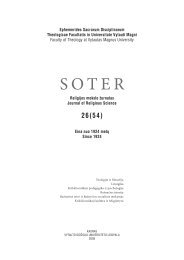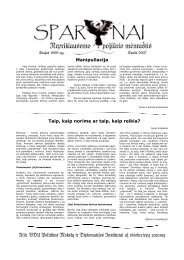Untitled - Vytauto Didžiojo universitetas
Untitled - Vytauto Didžiojo universitetas
Untitled - Vytauto Didžiojo universitetas
You also want an ePaper? Increase the reach of your titles
YUMPU automatically turns print PDFs into web optimized ePapers that Google loves.
oyars, the clergy legal residents, neighboring boyars and peasants, who had not<br />
accepted town rights.<br />
Internal order in towns changed along with the laws regarding towns. The role<br />
of the boyars was exceptional as the town municipalities were forming and as they<br />
were being reorganized. Residents of towns and townships relied on the boyars for<br />
their experience and sought their assistance in the struggles with elderships and<br />
royal estate administrations. It could be said that the towns movement would not<br />
have grown so widely without participation by the boyar social stratum. Central<br />
governmental institutions in small and large towns also encouraged boyars to<br />
become involved in the work of the municipalities.<br />
Grand Duchy stratum of nobles did not accept townspeople’s rights as<br />
actively and, not infrequently, this was also due to prompting by the ruler. Even<br />
the initiators of the reforms did not expect such an active movement in the towns<br />
and townships. It was inconceivable to the aristocrats of the Age of Enlightenment<br />
that illiterate people (who were the absolute majority of the townships and small<br />
townships) should be granted extended rights, freedom to elect a municipality,<br />
the ability to independently decide their town’s matters, collect taxes and, once<br />
acquiring such certain rights of citizenship, the possibility, albeit a theoretical<br />
one, to influence national processes. Thusly eldership administrators of small<br />
townships often classified residents along with peasants. Meanwhile the efforts<br />
by townspeople to gain the rights of personal inviolability and property security,<br />
which the new law guaranteed, would turn into open conflicts with the eldership<br />
and estate administrators.<br />
Town officials who had been protecting municipal traditions up to the Four-<br />
Year Sejm changed along with the new order of municipal elections. The frequent<br />
outbreaks of conflicts during the April 1792 elections indicate that new people<br />
were breaking into town municipalities, which means that the model of oligarchic<br />
rule was withdrawing from towns, and more democratic municipalities were<br />
developing. Every owner had the chance at a position, therefore some unpopular<br />
officials had to withdraw from office or take a more humble position in the<br />
municipal hierarchy. In small townships, the priority was given to their most<br />
active citizens, and boyars elected as vaitas (akin to prefects) especially frequently<br />
stepped in to lead them.<br />
During the time of the movement, the townspeople especially focused on<br />
recovering the townspeople community’s property, which the old, professed<br />
patents of rights guaranteed or which the lustration and inventory established. As<br />
signs of unity with other towns were forming, matters of specific, local importance<br />
comprised most of the requests directed to the ruler and to the Sejm. The attention<br />
of the townspeople concentrated on the past. Despite the expansion of rights and<br />
242





